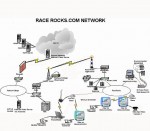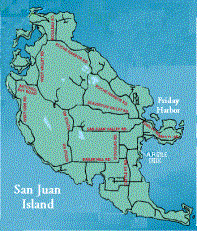Note: This description is now archival material since the network has been upgraded in 2007 .
by Ken Dunham
 Although relatively small in terms of overall network size, the technology involved in this project is actually quite sophisticated. This is not a typical network! Leading edge technologies and equipment is used throughout, and the engineering was far from trivial. However, all of the products and technologies in use are generally available on the market, and could be employed by any organization in any scale. All that is required is the vision to embrace them.
Although relatively small in terms of overall network size, the technology involved in this project is actually quite sophisticated. This is not a typical network! Leading edge technologies and equipment is used throughout, and the engineering was far from trivial. However, all of the products and technologies in use are generally available on the market, and could be employed by any organization in any scale. All that is required is the vision to embrace them.
The following offers some additional details on the design and the technologies in use. LGS handled the video capture/processing and WWW infrastructure, while Ken Dunham designed and implemented the network. GlenTel provided the wide area radio infrastructure, with tower assistance from TELUS
Local Area Network
Both the Lester B. Pearson College campus and Race Rocks have standard local area network. The LAN infrastructure at each location is provided by fast ethernet switches, with a router at the WAN termination point. Switches (rather than shared hubs) are required to provide modern network services such as voice and video. The routers are used to provide layer 3 services such as multicast, isolate local broadcast traffic to keep it off the wide area that has relatively scarce bandwidth (capacity), and terminate the VoIP telephone infrastructure (see the Voice section below for details).
Multicast is provisioned everywhere for efficient distribution of video. Modern Quality of Service (QoS) techniques are used to better service voice and video traffic. Almost all traffic is Internet-standard TCP/IP, but there is also a small amount of legacy AppleTalk due to the extensive use of Apple products. User desktops are a mixture of Windows/98, Windows NT, and MacOS X.
All webcasts on the island go either by wireless connection to APPLE AirPort base stations including several APPLE Extreme stations, or by hard wired Ethernet cables. The Apple G4 PowerBook is used on wireless when it is used for mobile webcasting.
As Race Rocks is relatively small (the main island is <100m across), all cabling there is Cat-5. The cabling there had to be done very carefully to avoid damage both to the sensitive environment, as well as the heritage light tower.
All of the network equipment (i.e. switches and routers) is from Cisco Systems.
Wide Area Network
As Race Rocks is located several kilometers offshore; getting a high capacity link there was not a trivial task. Three options in 2000 that were available were: satellite, broadband wireless, or undersea fiber optic cable.
A satellite-based solution was not economically feasible, as it would have involved high monthly costs for bandwidth. Undersea fiber optic cabling would have avoided any monthly costs once the up front (capital) costs were paid for, but was technically problematic for a number of reasons. One was that it wouldn’t have been cheap to lay. (special equipment and expertise is required). There are also environmental considerations re disturbing the seabed. A further complication was that the route would pass near by a military demolition range, and would have to be carefully routed in deep water to avoid any potential of damage.
The preferred solution turned out to be microwave radio. There is no operating cost once paid for, and the solution does not impact the environment. The radios (a “Tsunami” model in the unlicensed 5.8 GHz spectrum) and related engineering were purchased from GlenTel Communications. The Race Rocks light tower provided a convenient mounting post at that end, while at the College end Telus donated a 20m tower and installed it on a nearby hillside. One engineering issue was that rain (common in the area) can interfere with some microwave signals (as the radio waves are actually smaller than raindrops), but the frequency used avoided this problem.
The radios have standard ethernet ports for the local area connection, and thus are readily connected to any standard ethernet LAN. The network sees the wireless link as just another ethernet segment. The radios used provide a 4 Mbps full duplex facility (This system will be upgraded in 2005 to carry at least 10 Mbps full duplex).
WWW & Internet
The WWW site is actually a series of different servers in different locations. These servers are a variety of different platforms, with each optimized for the task at hand. For example, the server providing generic HTML pages is different than the one providing streaming video. These servers include Sun Solaris (UNIX), and Apple PowerMac G4s with Mac OS X Server, as well as a SONY SNC RZ30N camera server. The College has a broadband (high speed) connection to the Internet, provided by our partner Telus. The Video Streams are now hosted on an AKAMAI server, courtesy of the Apple Learning Interchange
Video
Video is captured from a variety of cameras. These range from hand held camcorders to CCTV systems commonly used as security cameras. The feed from each camera is connected to one or more host computers; the streamed video used around the clock is generated for Cameras 1, 2 and 5 using QuickTime Broadcaster software running from 3 Apple eMacs, Camera 3 is from an Apple G4.
Regardless of the source platform, the digitized video is transmitted across the network (LAN and WAN) back to Pearson College for further processing and distribution. IP multicast is used in the network as it allows for efficient distribution of each individual stream to multiple destinations.
Once at the College, the video streams from cameras 1,2,3,4 and 5 are distributed to the Akamai network web server. Camera 5 is also served independently by the SONY SNC RZ30N server software.
The video compression used in the digitization process can be anything up to full MPEG (>1 Mbps), with corresponding adjustments in the frame rate (fps). The only overall limit is the bandwidth capacity available between the video source and the viewing user. Relatively higher capacity streams can be used at the College due to the LAN capacity available there. At present, Internet constraints limit realistic distribution elsewhere to approx. 300 Kbps per stream, although we are planning to provide better quality video to our Internet viewers over time, as the overall Internet infrastructure continues to improve.
Audio
Due to its remote location, Race Rocks has never had the voice communications technology we all usually take for granted. In the past, VHF radiotelephone was the only means to “call” out, which is far from ideal, and is certainly not private. In recent years, cellular telephone access has been available, but this is far from cheap. Quirks of local geography mean that cellular calls are often completed by a carrier in Washington State, rather than the local carrier in British Columbia. Hence, any call can become international long distance.
Now standard telephones (including cordless units) and fax machines (the latter never before seen on the island) are connected. The network converts the voice and fax traffic into IP packets, which are transmitted across the data network just as any other packet would be. At the other end, the calls are converted back into standard telephony infrastructure, and are serviced by the College PBX just as any other telephone extension would be. This technology is called Voice over IP (VoIP). The PBX never knows what is happening in the middle; it simply thinks it is directly connected to the telephones and fax machines, even though they are miles away across the ocean.
Environmental Sensors
Various sensors (aka probes, and telemetry) are spread around the main island, both above the surface as well as under water. These connect back to a host PC computer via a variety of cabling technologies. The data from each sensor is processed on the host computer using National instruments Lookout software after being received by FieldPoint Hardware. An Apache Server is installed on the PC for Data Collection. It is then transmitted to the WWW server in batch updates or in real-time. In the future, we may use relational database technology to store the information as it is collected. This would allow for various queries and analysis to be run against the accumulated data store, rather than merely presenting the current information on the web page.
See this file on sensors:
Future Possibilities
In 2005-2006, the addition of the Tidal Power generator will mean that the Network on the island will be upgraded for more capacity to handle additional video and data sensor feeds from underwater.
A new Infra red camera is also being implemented for nighttime viewing in the seabird colony and in the marine mammal haul-out areas.
**Ken Dunham is an independent consultant who designs and builds sophisticated voice, video, and data network solutions for enterprises and service providers with complex technical and business requirements. He also consults with leading edge organizations on a variety of technology and related business issues, including network security. Ken designed and implemented the advanced network at Pearson College, and recently extended these facilities across the water to Race Rocks. Ken is a graduate of Pearson College, and has worked pro bono for the College and the Race Rocks project for the past five years.
kdunham (use the at sign) rogers.com
updated – May 2005- G,Fletcher
By 2007 several changes had been made updating the technology used at Race Rocks. These will eventually be reflected in an updating document.




